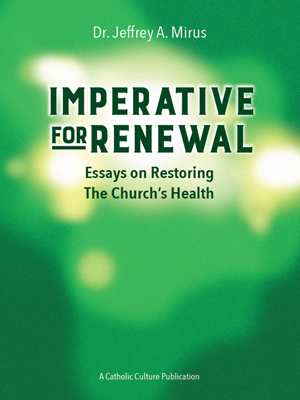The Seventeen Most Common Errors in the Liturgy
The Eucharistic liturgy is a beautiful offering to God, a treasure of the Church, yet it is not always celebrated according to the rubrics. The rubrics are spelled out in the General Instruction of the Roman Missal, but not all celebrants have found or taken the time to read them carefully. In fact, my experience is that most priests follow the rubrics for Mass quite well. Yet, there is a handful of errors, many minor, which seem to be rather common.
This small article is not an attempt to point out the more egregious errors such as changing the Eucharistic Prayer or having non-ordained persons read the Gospel and preach. It is rather an attempt to identify the small errors that good, sincere priests make, so as to make it easier for busy priests and deacons to correct them.
- The corporal is held up before being placed on the altar. This is not a problem when the corporal is being used the first time, but if it has been used before (as is often the case) this completely defeats the purpose of the corporal, which is to catch any particles of the host which fall on the altar. It should be placed on the altar and unfolded while lying flat on the altar.
- In some cases the corporal remains on the altar before and after Mass. The rite indicates that among the things prepared for Mass are "On the credence table: the chalice, a corporal, a purificator, and, if appropriate, the pall; the paten and, if needed, ciboria . . ." (GIRM n. 118c) "If no deacon is present, after the Prayer of the Faithful is concluded and while the priest remains at the chair, the acolyte places the corporal, the purificator, the chalice, the pall, and the Missal on the altar." (GIRM 190)
- While praying the sacerdotal prayers, the priest holds his hands in a way that does not convey the intended message: that he is "imitating the Lord in His passion " and thus "we bear witness to Him as we pray." (Ceremonial of Bishops, n. 104) The priest is to hold his hands "slightly raised and outstretched," and, it seems, is to appear as Christ on the cross.
- When there is a concelebrant and no deacon, the main celebrant often proclaims the gospel himself. However the rite calls for a concelebrant to proclaim the gospel: "By tradition, the function of proclaiming the readings is ministerial, not presidential. The readings, therefore, should be proclaimed by a lector, and the Gospel by a deacon or, in his absence, a priest other than the celebrant." (GIRM 59)
- Sometimes the concelebrating priest (in the absence of a deacon) will not request the blessing from the bishop, and other times the concelebrating priest will ask for the blessing from the main priest concelebrant. "When the Alleluia is begun, all rise, except for a Bishop, who puts incense into the thurible without saying anything and blesses the deacon or, if there is no deacon, the concelebrant who is to proclaim the Gospel. In a concelebration where a priest presides, however, the concelebrant who in the absence of a deacon proclaims the Gospel neither requests nor receives the blessing of the principal celebrant." (GIRM 212)
- Concelebrants often do not hold their hands apart when praying the common part of the Eucharistic prayer after the consecration. The rite calls for the concelebrants to extend their hands. (GIRM 222, 227, 230, 233. These references are to the instruction for each of the four Eucharistic Prayers and indicate that the hands are to be extended for the words immediately following the words of consecration. For example, in n. 227, for the second Eucharistic Prayer, "all the concelebrants speak all the following together . . . d. The Memores igitur (In memory of his death) and the Et supplices (May all of us who share) with hands extended.")
- The Lectionary or book of Gospels is often held up after the priest or deacon proclaims the gospel, when saying, "The word of the Lord. " It seems that one of the reasons the ending proclamation was changed (from "this is the word of the Lord") was to eliminate the practice of holding up the book at this time. The proclaimer is saying "[What I just proclaimed is] the word of the Lord." ("At the end of the Gospel, the deacon proclaims The Gospel of the Lord without raising the book from the stand . . ." from April-May 2000 BCL Newsletter . . .)
- The deacon or priest on occasion gives the Dismissal as "The Mass is ended; go in peace to love and serve the Lord." This is not one of the options for the dismissal. It is a combination of B and C in the sacramentary. (p. 567)
- The celebrant or concelebrant sometimes bows to the Blessed Sacrament to say the short prayer "Almighty God, cleanse my heart and my lips . . ." before reading the Gospel. "A bow of the body, that is to say a profound bow, is made to the altar; during the prayers Munda cor meum (Almighty God, cleanse my heart) and In spiritu humilitatis (Lord God, we ask you to receive) . . ." (GIRM 275b)
- The celebrant often omits the bow of the head called for at the name of Mary in the Eucharistic prayer, and also at the name of the saint whose feast is being celebrated. The rite calls for this bowing of the head for both of these names (but not for the patron saint of the parish: "A bow of the head is made when the three Divine Persons are named together and at the names of Jesus, of the Blessed Virgin Mary, and of the Saint in whose honor Mass is being celebrated . . ." (GIRM 275)
- The cantor or the person reading the Gospel sometimes reads the Alleluia before the Gospel. The Alleluia is to be sung (or, it may be omitted). "[The Alleluia] is sung by all while standing and is led by the choir or a cantor, being repeated if this is appropriate. The verse, however, is sung either by the choir or by the cantor. a. The Alleluia is sung in every season other than Lent. The verses are taken from the Lectionary or the Graduale. b. During Lent, in place of the Alleluia, the verse before the Gospel is sung, as indicated in the Lectionary." (GIRM 62). "The Alleluia or verse before the Gospel may be omitted if they are not sung." (GIRM 63c)
- Sometimes the priest will give the blessing as "May almighty God bless us. . ." The rite doesn't allow for this, but calls for the priest to say, "May almighty God bless you . . ." or another blessing directed to "you," not "us." (Sacramentary p. 566)
- When there is a concelebrant and no deacon present the principal celebrant will say, "Let us offer each other the sign of peace." According to the Rite, the concelebrant is to say this: "After the deacon or, when no deacon is present, one of the concelebrants has said the invitation Offerte vobis pacem (Let us offer each other the sign of peace), all exchange the sign of peace with one another." (GIRM n. 239) (a surprise to this author!)
- Sometimes the concelebrants will kiss the altar before departing. The rite calls for them to bow. "Before leaving the altar, the concelebrants make a profound bow to the altar. For his part the principal celebrant, along with the deacon, venerates the altar with a kiss in the usual way." (GIRM 251)
- Sometimes when the priest or deacon says, "The Lord be with you." before reading the Gospel, he extends his hands. The rite calls for the priest's or deacon's hands to be joined at this point: "At the ambo, the priest opens the book and, with hands joined, says, Dominus vobiscum (The Lord be with you), and the people respond, Et cum spiritu tuo (And also with you)" (GIRM 134). "There [at the ambo] the deacon, with hands joined, greets the people, saying, Dominus vobiscum (The Lord be with you)." (GIRM 175)
- At times the celebrant will ask, for petitions from the congregation during the prayer of the faithful. The rite does not seem to allow for this. According to the GIRM (71) "The intentions are announced from the ambo or from another suitable place, by the deacon or by a cantor, a lector, or one of the lay faithful. The people, however, stand and give expression to their prayer either by an invocation said together after each intention or by praying in silence." (See also GIRM 138.)
- At times a concelebrant will arrive late for a Mass and go out on the altar after the Mass has begun. The rite does not allow this. "No one is ever to enter into a concelebration or to be admitted as a concelebrant once the Mass has already begun. (GIRM n. 206)
Now admittedly, most of these are small things, but when we are celebrating the "source and summit" of the Christian life, it would seem to be worthwhile to try to follow the Instruction. This stems from not only the desire to be obedient, which most priests have, but also the desire to be uniform in our celebration of the sacred mysteries (where uniformity is called for). It causes fewer distractions if we all conform to the rubrics.
Furthermore, some of the gestures mentioned herein, such as bowing the head at the name of Mary and holding the hands in imitation of Christ in his passion are beautiful. In any event, I am confident that most priests or deacons who may be erring in these small things will be happy to make the necessary changes.
Reverend Thomas G. Morrow has a doctorate in sacred theology from the John Paul II Institute for Studies on Marriage and the Family. His book, Saints and Families (Emmaus Road), a compilation of 27 lives of the saints appropriate for family reading time, appeared in 2002. He is a parochial vicar at St. Catherine Laboure Parish in Wheaton, Md. He is the author of the book Christian Courtship in an Oversexed World (OSV, 2003) and his published booklets and leaflets can be seen at www.cfalive.org. His last contribution to HPR appeared in February 2007.
This item 7646 digitally provided courtesy of CatholicCulture.org






